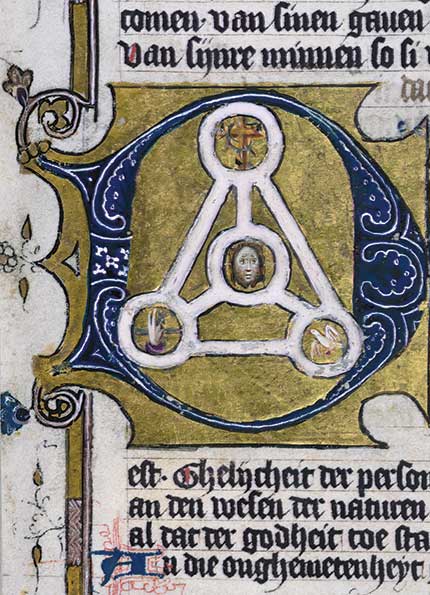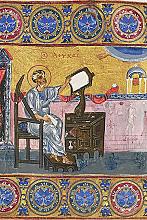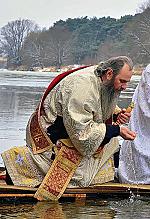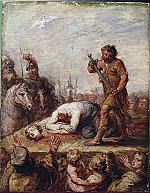Trinity, All Saints, Christ the King

[ABOVE: Symbolic representation of the Trinity in Duke Albrecht’s Table of Christian faith (winter part), Walters Ms. W.171, f.2r. 1400 to 1404. Utrecht, Netherlands. Parchment—Public domain, The Walters Art Museum, Baltimore]
Once we pass Pentecost, we are in Ordinary Time (see the next section). However, the first and last Sundays of Ordinary Time, as well as All Saints’ Day within it, have historically been considered special.
Where did they come from?
Trinity Sunday, celebrated as the first Sunday after Pentecost, is a Western feast; Eastern Orthodoxy acknowledges and celebrates the Trinity as part of the church’s celebrations of Pentecost. While special prayers and offices devoted to the doctrine of the Trinity date back as far as the fourth-century Arian controversy, the Sunday was not set as a feast in the West until the fourteenth century.
The West celebrates All Saints’ Day on November 1; the East celebrates it on the Sunday after Pentecost. Some kind of remembrance of saints on their death days began as early as the second century, and by the fourth century, a general celebration of Christian martyrs was being held sometime in or near the Easter season. In the ninth century, the Catholic church moved the Western celebration to November 1.
Christ the King Sunday, like Trinity Sunday, is only celebrated in the West, and is a much newer feast. The Roman Catholic church officially added the Feast of Christ the King to its liturgical calendar in 1925, to be celebrated on the last Sunday of October; Catholics moved the feast to the last Sunday before Advent in 1970, after Vatican II. It has been adopted in this form by many liturgical Protestant churches. (We’ll discuss Kingdomtide, a related season among some Protestants, in the next section.)
How are their dates determined?
Trinity Sunday’s date is determined by the dates of Easter and Pentecost and will fall between May 17 and June 20. All Saints’ Day in the West is always on November 1, although it is sometimes celebrated on the following Sunday; in the East it is the Sunday after Pentecost. Christ the King is always the fifth Sunday before Christmas Day. It can fall anywhere between November 20 and 26.
Theological themes
For Trinity Sunday the theme is obviously the doctrine of the Trinity in all its depth and mystery.
Observances of All Saints often honor and remember the lives and witness of all deceased Christians; technically, November 1 commemorates named saints and November 2, All Souls, commemorates all the faithful departed.
Christ the King speaks to us of how Christ is Lord over all of creation and all earthly powers.
Colors
Although green is normally used for the rest of Ordinary Time, white is used for these feasts in the West. Gold is used in the East for All Saints.
Customs
Trinity and Christ the King have no particular customs other than the use of a creed on Trinity and the celebration of the Eucharist on both (most liturgical churches will already be doing this every Sunday anyway).
All Saints’ Day is also celebrated with a Eucharist in both East and West and is considered to be an especially appropriate day for baptisms. In the West, almost invariably, names of congregation members who have died during the last year are read during the service; in the East services focus more on official saints and martyrs, named and unnamed. (The saints local to an Orthodox parish are often celebrated on the Sunday after All Saints.)
Halloween’s history is complex, but as its full name (All Hallows’ Eve) indicates, it partially developed out of the vigil services held for All Saints’ Day, and some (definitely not all!) Halloween customs around the world have Christian roots. CH
Some things you can do at home
• Read Scriptures connected to the doctrine of the Trinity and the doctrine of the Lordship of Christ. (The Trinity is, of course, not mentioned in the Bible by name, but many passages speak of the Triune God acting.)
• Whatever your feelings about participating in secular Halloween activities, you can make time to talk about Halloween’s origins as the eve of All Saints and to use it as an occasion to remember that Christ has defeated death. Some people who dress up do so as heroes from the Bible, from literature, and from historical events.
• On All Saints’ Day and All Souls’ Day, remember those people from church history or your own family history who have been models of Christ-likeness to you. (Some Protestants celebrate October 31 as Reformation Day due to that being the day Luther first promoted his 95 Theses.)
By Jennifer Woodruff Tait
[Christian History originally published this article in Christian History Issue #156+ in 2025]
Jennifer Woodruff Tait is Senior Editor of CH magazineNext articles
Ordinary Time, especially Sundays after Pentecost
The term “ordinary” refers to the ordinal numbers used in counting Sundays (First, Second, Third, etc.).
Jennifer Woodruff TaitCelebrating the saints: the sanctoral cycle
Saints are normally honored on the anniversary of their death
Jennifer Woodruff TaitRecommended resources: Fasts and Feasts
Learn more about the history of the Christian year, and get ideas for incorporating celebrations into your own life.
The editorsSupport us
Christian History Institute (CHI) is a non-profit Pennsylvania corporation founded in 1982. Your donations support the continuation of this ministry
Donate







